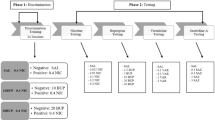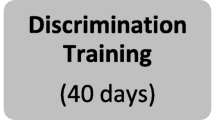Abstract.
Rationale: Previous drug-discrimination studies have, with the exception of nicotine (NIC), demonstrated tolerance to the cue effects of a broad range of drugs of abuse. Barrett et al. have shown that tolerance to a drug's cue properties reflects drug-induced rebound shifts in the discrimination baseline and not a weakened or less salient cue. Objectives: The objective of the present study was to use a discrimination task sensitive to bidirectional cue changes to characterize the interoceptive cues associated with both the primary and rebound cues produced by nicotine in an attempt to understand why a recent study by Shoaib et al. failed to observe tolerance to the nicotine cue. Methods: Since dopamine (DA) has been implicated in mediating the NIC cue, rats were trained to discriminate between 0.25 mg/kg amphetamine (AMPH), an indirect DA agonist, and 0.033 mg/kg haloperidol (HAL), a DA antagonist at the D2 receptor site. Training doses were chosen so that rats responded about equally on both levers when tested on saline (SAL) following acquisition. This procedure provided a behavioral baseline to assess NIC-related changes along a presumed continuum of DA-mediated cues. Following acquisition of the discrimination: (i) NIC substitution tests were conducted, (ii) rats were tested for lever choice at intervals from 2 h to 48 h following treatment with single doses of 0.25 mg/kg and 0.50 mg/kg NIC, and (iii) rats were challenged with test doses of NIC during a period of NIC rebound. Results: (i) NIC substituted for AMPH in a dose- dependent manner. (ii) At short intervals after treatment with 0.25 mg/kg and 0.50 mg/kg NIC, rats responded primarily on the AMPH lever followed by a shift to predominant responding on the HAL lever 16–24 h post-treatment, before returning to predrug levels. (iii) No evidence was observed for acute tolerance to NIC. Conclusions: The robust and long-lasting rebound cues associated with training level doses of NIC suggest that maximal tolerance would likely develop to the NIC cue during the acquisition phase of the conventional NIC–saline discrimination study.
Similar content being viewed by others
Author information
Authors and Affiliations
Additional information
Electronic Publication
Rights and permissions
About this article
Cite this article
Barrett, R.J., Caul, W.F., Stadler, J.R. et al. Long-lasting rebound cue effects following single doses of nicotine and amphetamine: implications for understanding tolerance. Psychopharmacology 157, 349–357 (2001). https://doi.org/10.1007/s002130100823
Received:
Accepted:
Issue Date:
DOI: https://doi.org/10.1007/s002130100823




